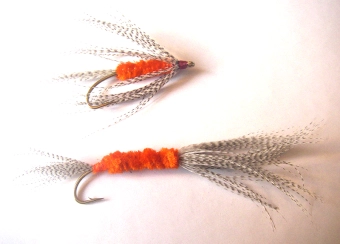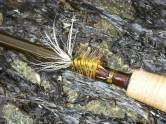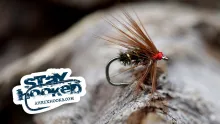Kelvin Kleinman shows us how to tie a really different saltwater fly based on the freshwater spider style, adapted for cutthroat stream fishing and then reversed to become a saltwater shrimp from outer space! A very special but also efficient pattern.
This is another pattern that I developed, which I have had amazing success with. I call it the Double K Reverse Spider
This is a pattern originally developed for fishing the Stillaguamish River for Sea Run Cutthroat trout by Al Knudsen in the 1920's and then altered by guide Mike Kinney in the 1970's the materials are the same but the way they are tied in are reversed. These flies are known as the Knudsen Spider and the Reverse Spider.
The traditional Knudsen has chenille tied in as the body with a mallard flank palmered in a way that it the flank folds back over the body and, in fact, almost completely masks it.
The hackle is tied in first, immediately behind the hook's eye, by the tip, with the stem curving down and forward of the hook eye. It is wound back along the hook shank, one turn immediately behind the last it helps to shape the feather fibers forward to form a tight cone with the tips pointing out over the eye.
So the fly is tied from the eye to the bend where it is tied off.
The cone that is formed by the feather fibers has an amazing amount of movement and life like appearance when stripped.
The slightest current or movement of the fly causes the coned shape flank to pulse in the water.
The reverse spider has been a "go to fly" for sea-run cutthroat anglers in Washington and Oregon in both salt and fresh water for these anadromous fish.
While working on a shrimp imitation pattern I developed a double Reverse Spider which includes a second Mallard flank or Guinea Fowl feather half way down the shank of the hook.
I also replaced the chenille with dubbing so I could better control the taper of the fly and have a wider range of colors to the fly. I also tie a version with a hackle palmered toward the rear of the hook I call this version the Tsunami Warning based on the wake fish leave chasing this fly. Surprisingly I found the added mallard flank gave the fly more buoyancy and found when stripped quickly the fly will leave a wake from the water it displaces as it moves through the subsurface.
Watching large fish torpedo toward it as it moves along just under the surface prior to the strike can be as much fun as the fight once they are on.
I have often caught fish after fish on this fly while others fishing the same beach go without so mush as a hit.
While this was initially intended to be a salt water beach fly the amount of lifelike movement in it has hooked steelhead in rivers and small- and largemouth bass in lakes.
|
|
|
|
|
|
|
|
|
|
|
|
|
|
|
|
|
|
|
|
|
|
|
|
|
|
|
|
|
|
|
|
|
|
|
|
|
|
|
|
|
|
|
|
- Log in to post comments




















































Sweet fly, been catc
Sweet fly, been catching plenty on the Sol Duc. Angry takes.
I love these flies!
I love these flies! I'm tying a few larger sizes and incorporating glass beads for the body and I'm going to use them for steelhead. Great instructions on this site.
Wow!!! I saw a fella
Wow!!! I saw a fella fishing a reverse spider on the water a while ago, and have been tying it as best I can (from memory) for maybe two or three years now..... It's an awesome cut throat fly, and now I have some great variation ideas!!! Thanks so much! I love this fly!!!!!!!!